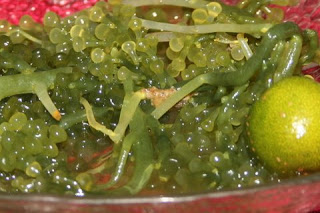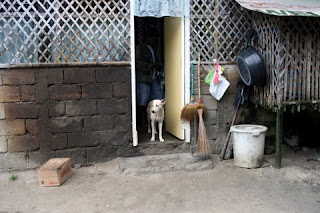 Mango-pomelo shake. Score!
Mango-pomelo shake. Score!When I'm in the province, I usually veer away from restaurants that seat more than twenty people. Such places usually eschew the amazing diversity in Philippine vegetables and go with the ubiquitous and horrible chopsuey that has invaded our islands. Because the vegetables used in them (broccoli, cauliflower, cabbage, etc.) are more expensive, they are presumed to be more "high class" than the lowland
pinakbet sort. It is sad indeed, and I have spent many sad nights sipping sugary mango shake while dreaming of something other than a mediocre cornstarch-laden excuse for a meal.
Life is good, then, when you discover a place like Ka Lui in the heart of a small city like Puerto Princesa.
Ka Lui is named after its owner Lui
(
Ka is an appellation that Filipinos use when referring to an elder, from the word
kapatid or sibling). Everyone who's been there will, without fail, mention something like "I love the ambiance". It's all bamboo and wood, with native and natural decor. It's all tastefully thrown together, and the end-result is different from all the other places informed by their island-ness.
As you enter, you are asked to remove your shoes. Be sure to put them somewhere conspicuous-- as the place gets packed, footwear accumulates at the entrance! Inside are areas where you can eat from the floor, as well as plenty regular tables. The staff is extremely attentive and well-trained.
Ka Lui serves only seafood and vegetables, with no processed sweets and softdrinks. Only recently did they start producing printed menus for their diners. Ah! Seasonal peepz! A good indicator of a good restaurant.
 Suka (vinegar) and toyo (soy sauce) at the table.
Suka (vinegar) and toyo (soy sauce) at the table.I first had the
lato salad. When I was a child, I thought that these "grapes of the sea" were octopus eggs and regarded them with a sort of awe and fear. They turned out to be
Caulerpa racemosa, a seaweed with little sacs that don't taste like grapes at all, but are pretty much filled with seawater. Eating them is all about texture and consistency-- they pop in your mouth like caviar! The usual vinegar or
calamansi dressing complements the salty nature of
lato.  Nobody should ever miss a chance to eat fresh lato.
Nobody should ever miss a chance to eat fresh lato.Next I had
pako or fern tops sauteed in garlic, ginger, and peppers. This was surprisingly flavorful. What a simple dish!
 Gingery pako.
Gingery pako.The highlight for me, though, was the ridiculously delicious mango-pomelo shake. A good departure from the regular mango version, this is something I'll try at home very soon. A slice of ginger in the blender would render this drink as perfect.
Dessert was fresh fruits served inside a
buko or coconut shell, and sprinkled with mascobado sugar. You can scrape the meat out of the coconut and eat it, if you're not full to the point of indigestion yet.
Ka Lui369 Rizal Avenue, Puerto Princesa, Palawan
(+6348) 433 2580















































